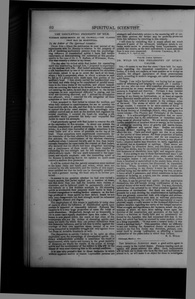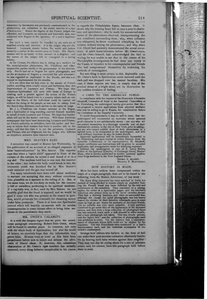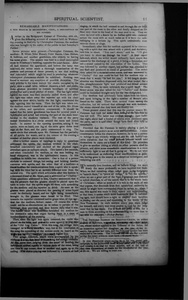< Demoniality (continued from page 3-113) >
Father Sinistrari was by no means an obscure person in his own day; he enjoyed general esteem, and filled many important offices. Born in 1622, he was for fifteen years Professor of Theology at Pavia, and subsequently became Vicar-General of the diocese of Avignon, and theologian to the Archbishop of Milan, was attached to the tribunal of the Inquisition, and compiled a criminal code for the Franciscan Order, to which he himself belonged. He died in 1701.
To Father Sinistrari’s treatise may be added a more celebrated curiosity of diabolical literature, for the republication of which we are also indebted to M. Liseux. The ardent imagination of Luther, it is well known, led him to translate his spiritual conflicts into the language of material symbolism, and sometimes he did not accurately distinguish between the symbol and the reality. It is doubtful whether he may not have actually believed himself to have unsuccessfully defended the doctrine of the Mass against the fiend in the days of his orthodoxy; if this was not so, the disputation at least presented itself to his mind as an effective allegory, and he did not perceive that he was exposing himself to the reproach of having derived his arguments from the Devil. The weapon thus incautiously offered to opponents was grasped in the next century by the Abbe de Cordemoy, who republished Luther’s dialogue with a commentary to prove that the Reformer, on his own showing, forsook the Church at the instigation of Satan. The point is a perfectly fair one, and though neither Luther’s nor the Abbe’s jeu d’esprit is likely to have much influence on opinion in our day, each is well worth preserving as a literary curiosity. M. Liseux has translated Luther’s text into French, and the Abbe has involuntarily evinced his sense of the speciousness of the Devil’s arguments by accompanying them with brief controversial notes.
Dr. Wyld on the Philosophy of Spiritualism
Syr, — It seems to me that the views I have held for many years regarding the dynamical constitution of physical bodies, if it does not explain, at least enables us to accept as possible, the alleged appearance of those presentations which, according to modern language, are called materialized spirit forms.
Though I am not a Spiritualist, not having had an opportunity of witnessing and judging for myself, yet I confess I am not one who can treat with contempt phenomena which are attested by so many seemingly competent and credible persons in England and America. Perhaps it may interest some of your readers it I explain what appears to be the bearing of my theory on Spiritualism, or at least as regards these abnormal manifestations to which I have referred. To begin then, I do not believe in matter in the ordinary sense of the word. The atoms of which all visible and tangible things consist, I conceive to be mere centres of force. I gave my reasons for holding this opinion in a paper read to the Royal Society of Edinburgh (March, 1865), and again in a recent volume—The Physics and Philosophy of the Senses, chap. i. It is acknowledged by philosophers that we never perceive matter, that is, the substratum or immediate underlying cause of physical bodies. We are merely conscious of certain exhibitions of localized force or energy, as for instance of solidity or resisting force of gravity and inertia forces, acting in different and special ways. Bodies are visible because of their repelling the luminous vibrations which affect the eye. Taste and smell again are due to an action on the nerves of these senses. All these properties of bodies evidently imply energy or power, and we are conscious of nothing else than force, or the results of force, in any physical body; physical bodies may therefore be fairly regarded, not as natural, but as dynamical or spiritual. Their atoms are held together by attractive force, and this force, as modem science has shown, may be successively resolved into equivalent measures of electricity, heat, light, and magnetic attraction. Force acting in any of these last-mentioned ways I call free anatomatic or transmissible force, while solid, visible, and tangible bodies I call atomic bodies, because force in them is localized or materialized in the atomic form, which is not the case, as far as science has discovered, in transmissible force. When, therefore, a spirit becomes visible and tangible, according to my theory it must be held that the spiritual being has the ability of converting the free, an atomic force which it possesses, and which constitutes in fact the essence of its being as a spirit, into the atomic constitution peculiar to visible, solid bodies.
If, then, it can be proved that spirits can thus materialize themselves, this will furnish strong confirmation of the dynamical theory of the world which I hold. You may, therefore, believe that I am actuated by no blind prejudice against the phenomena of Spiritualism. But there are much stronger grounds for a man desiring the establishment of Spiritualism; there are grounds connected both with religion and philosophy which should induce most men to welcome phenomena which, by establishing the verity of the supernatural or superphysical, supply a ready answer to the thousand objections of modern skeptics regarding the verity of the Gospel narrative. What strength and significance, for instance, would the phenomena of which we have been talking throw upon the doctrine of the resurrection and ascension of the body of Christ! — a doctrine so fondly held and so persistently enforced by the Apostles who had sojourned with him in the flesh, but which has been so scorned by some modern critics as a thing impossible. “It was sown a natural body; it was raised a spiritual body.” This assertion offers no difficulty to any one holding the dynamical theory of matter, and it occurs to me that this theory may therefore, perhaps, commend itself to devout Spiritualists as affording a natural explanation of the phenomena in which they believe.
Edinburg, March 31, 1876.
A Card to the American Public
In compliance with the request of the Honorable Alexandre Aksakoff, Counselor of State in the Imperial Chancellery at St. Petersburg, the undersigned hereby give notice that they are prepared (o receive applications from physical mediums who may be trilling to go to Russia, for examination before the Committee of the Imperial University.
To avoid disappointment, it may be well to state, that the undersigned will recommend no mediums whose personal good character is not satisfactorily shown; nor any who will not submit themselves to a thorough scientific test of their mediumistic powers, in the city of New York, prior to sailing; nor any who cannot exhibit most of their phenomena in a lighted room, to be designated by the undersigned, and with such ordinary furniture as may be found therein.
Approved applications will be immediately forwarded to St. Petersburg, and upon receipt of orders thereon from the Scientific Commission or its representative, M. Aksakoff, proper certificates and instructions will be given to accepted applicants, and arrangements made for defraying expenses.
Address the undersigned, in care of E. Gerry Brown, Editor of the Spiritual Scientist, 18 Exchange Street, Boston’ Mass., who is hereby authorized to receive personal applications from mediums in the New England States.
Henry S. Alcott. Helena P. Blavatsky.
How Tyndall Proposed for His Wife
...
<Untitled> (The Princess Isabeau de Beauvau-Craon)
The Princess Isabeau de Beauvau-Craon, an ardent student of Spiritism, magnetism, astronomy and other sciences, whose mother applied to the Tribunal of the Siene, for an injunction against her daughter, on the plea of her insanity, has gained her case, and the Princess’ mother has been mulucted in the costs. The Tribunal did not see that a person loving the exact sciences must have a diseased brain.
<Untitled> (Madame Blavatsky, now on Philadelphia)
Madame Blavatsky, now in Philadelphia, is furnishing American news of Spiritualism, in Russian, for a St. Petersburg journal.
Singular Coincidence
The Amador (Cal.) Ledger, says: We have been informed by Mr. Andrews—father of Mr. Thomas Andrews, whose unaccountable death we announced last week—that a few days before the death occurred his son had a very impressive dream “that had become possessed of two bodies—one a human body, the other a spiritual body; that his spiritual body was perched upon a barn and the human body lying upon the ground being devoured by hogs.’' Only a short while after this dream, which appeared to trouble him a great deal, bis body was found dead near a barn, and the hogs had almost completely devoured the dead body. Whether this dream had any connection with the sad occurrence that followed, we leave our readers to form their own conclusions. We cannot say but what the spiritual body, in reality, sat upon the barn, as indicated in the dream, and witnessed the devouring of the human body by the hogs. To say the least, this appears to be a very strange coincidence.
Editor's notes
- ↑ Dr. Wyld on the Philosophy of Spiritualism by Wyld, R. S., Spiritual Scientist, v. 4, No. 8, April 27, 1876, p. 92. From the London Spiritualist
- ↑ A Card to the American Public by Olcott, H. S.; Blavatsky, H. P., Spiritual Scientist, v. 2 No. 18, July 8, 1875, p. 211
- ↑ How Tyndall Proposed for His Wife by unknown author
- ↑ The Princess Isabeau de Beauvau-Craon by unknown author, Spiritual Scientist, v. 3 No. 1, September 9, 1875, p. 11
- ↑ Madame Blavatsky, now on Philadelphia by unknown author
- ↑ Singular Coincidence by unknown author, Spiritual Scientist, v. 3 No. 4, September 30, 1875, p. 38




